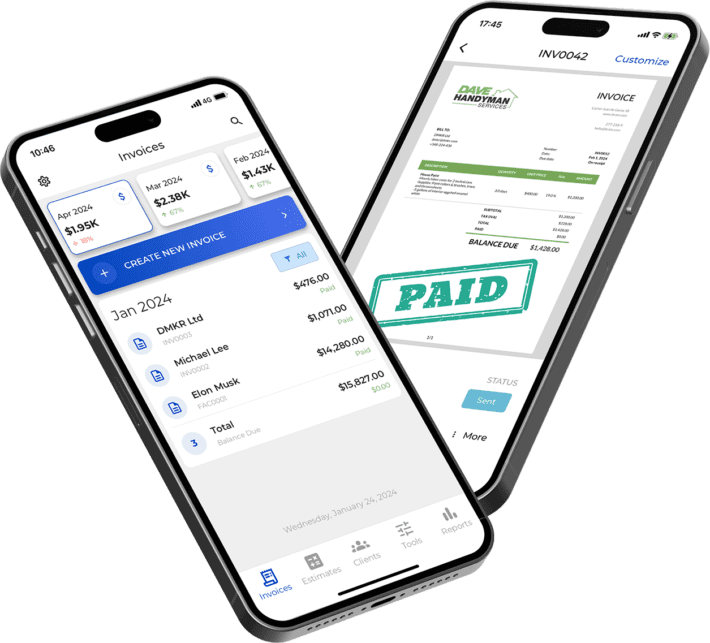Roofing Insurance: Coverage, Costs, and Best Providers

Table of Contents
Roofing is tough and risky work. Roofers have to deal with working at great heights, handling heavy tools, and facing unpredictable weather. Job sites can be full of dangers. Just one accident, theft of your tools, or a customer getting hurt could cost you thousands of dollars unless you’re properly protected.
That’s why roofing insurance is important. With the right insurance coverage, your tools, workers, vehicles, and business are protected if something unexpected happens. Plus, many homeowners and general contractors won’t even hire you unless you can prove you’re insured.
This guide explains what types of insurance roofers need, how much it usually costs, and which companies offer the best coverage. It also shows you how to file a claim if something goes wrong and gives tips on how to save money on insurance while staying protected.
Get Started with Invoice Fly’s Software
Invoice Fly is a smart, fast, and easy-to-use invoicing software designed for freelancers, contractors, and small business owners. Create and send invoices, track payments, and manage your business — all in one place.

Why Roofers Need Insurance
Insurance isn’t just a good idea, but a must for roofers.
- It gives you financial protection: If someone trips over your ladder, or if your crew accidentally drops a tool that damages a client’s car, insurance helps pay the bill so you don’t have to cover everything yourself.
- It gives you legal protection: Most states and many cities require roofers to have certain types of insurance, especially General Liability and Workers’ Compensation. If you don’t have these, you could face fines or even be banned from working on jobs.
- It proves you are trustworthy: Being “bonded and insured” shows clients that you run a trustworthy, reliable business. It can be the difference between getting hired or being passed over. Insurance should be one of the first things you consider when starting a roofing business.
What Does “Bonded and Insured” Mean?
When you hear the terms “bonded and insured,” it’s important to understand what each one means and what the difference is, especially in roofing and contracting.
Insured means your business has insurance policies that pay for certain problems, like accidents, injuries, or property damage. For example, if something goes wrong on a job and there’s an accident, your insurance can help cover the costs.
Bonded means a company (called a surety company) promises your client that you will finish the job properly and follow the contract. If you don’t finish the job or if you break the contract, the surety company will pay your client, but then you have to pay the surety company back.
Bonds are often required for public jobs, such as work on schools or government buildings. Sometimes, homeowners or private clients ask for bonds too, especially on larger or more expensive projects.

Types of Insurance Roofers Should Have
Each type of insurance covers different risks you face every day on the job.
1. General Liability Insurance (GL)
What it covers: Injury or property damage you cause to others. If your crew accidentally breaks a neighbor’s window or someone trips over your ladder, this is the insurance type that can protect you and your business.
Why it matters: This is the foundational insurance almost all clients expect. It protects you against lawsuits from third parties.
Coverage limits: Commonly $1 million per incident and $2 million total per year for residential jobs. Commercial contracts often require higher limits.
Pro tip: Ask for “occurrence-based” coverage, which protects you for incidents that happened while the policy was active even if the claim is filed years later.
2. Workers’ Compensation Insurance (WC)
What it covers: Medical bills, rehabilitation costs, and lost wages if your workers get injured on the job.
Why you need it: Roofing is dangerous work with risks of falls, heavy materials, and extreme weather. Most states legally require WC if you have even one employee.
Important: Even if a worker is labeled as a 1099 subcontractor, your state might still require you to cover them. Always check local laws carefully.
3. Commercial Auto Insurance
What it covers: Vehicles used for work, like trucks and vans, including accidents, damage, and theft.
Why personal insurance isn’t enough: Most personal auto policies won’t cover vehicles when used for business purposes like hauling tools or materials.
When you need it: If you drive to job sites, tow trailers, or transport equipment, commercial auto insurance is a must.
4. Tools & Equipment Insurance
What it covers: Portable roofing tools and equipment like nail guns, compressors, generators, even if they’re stolen from a locked trailer or damaged on the job.
Why you need it: Tool theft and damage are very common in roofing. This insurance helps you replace gear quickly without huge out-of-pocket costs.
Pro tip: Maintain a detailed inventory of your tools with serial numbers, purchase dates, and values to avoid underinsuring.
5. Commercial Property Insurance (or Business Owner’s Policy)
What it covers: Your business premises (office, warehouse), stored materials (like shingles), and fixed equipment against fire, theft, or certain weather damage.
Why it matters: Even if you rent your workspace, your tools and materials can be vulnerable to loss.
BOP meaning: A bundled policy combining General Liability and Property Insurance, often offering small businesses a discount.
6. Professional Liability Insurance (Errors & Omissions, or E&O)
What it covers: Mistakes in advice, consultation, design, or specifications that lead to financial loss or damage.
Example: You recommend a roofing system that later leaks because of incorrect specifications. E&O insurance helps cover rework costs or legal fees.
Why roofers need it: If you provide design, consultation, or warranty advice, this coverage protects you from claims based on errors or omissions.
7. Surety Bonds
What it covers: Guarantees that you will fulfill contractual obligations, pay subcontractors and suppliers, and follow regulations.
Why you need it: Bonds are often required for licensing, public works, commercial projects, and sometimes even large private jobs.
How it works: If you fail to meet contract terms, the surety company pays your client, then seeks reimbursement from you.
8. Umbrella or Excess Liability Insurance
What it covers: Extra liability protection that kicks in once your other policy limits (like GL or WC) are exceeded.
Why it matters: One large lawsuit can easily surpass $1 million. Umbrella policies add $1 to $5 million in additional coverage for a relatively low cost, providing a crucial safety net for high-risk or large projects.

Roofing Insurance Cost Estimates
Roofing insurance can get expensive but it’s a lot cheaper than paying for accidents, injuries, or lawsuits out of pocket. The total cost depends on things like how many workers you have, what kind of jobs you do, and where your business is located.
Here are the main factors that affect your roofing insurance costs:
- Payroll size and number of employees
- Job type (residential vs. commercial)
- Claims history (Have you had past accidents or lawsuits?)
- Location (High-risk weather or theft areas may cost more)
- Safety programs and driver records (Safer companies often get better rates)
Average Monthly Costs by Policy Type
Policy Type | Estimated Monthly Cost |
General Liability | $200 – $350 |
Workers’ Comp | $9.90 – $15.25 per $100 of payroll |
Commercial Auto (per truck) | $140 – $220 |
Tools & Equipment | $10 – $25 |
Commercial Property / BOP | $80 – $150 |
Umbrella Policy ($1M–$2M) | $60 – $150 |
Professional Liability (E&O) | $50 – $120 |
Surety Bonds | Varies by bond amount and your credit score |
Disclaimer: These estimates are for educational purposes only. Verify costs with the provider of your choosing before buying insurance.
Tips to Lower Your Insurance Costs:
- Bundle policies with one provider
- Keep claims low by following safety rules and using protective equipment
- Train your workers regularly, especially on ladder and fall safety
- Keep good records including driver logs, tool lists, and safety training
How to Get Roofing Insurance Step-by-Step
Whether you’re a solo roofer or running a growing crew, here’s how to get the right roofing insurance coverage.
Step 1: Understand What Needs Protection
Before you shop for insurance, take time to list out the risks in your business. Think about what you have and what your work involves.
- The type of environment you work in
- Employees or subcontractors who work under you
- Trucks, vans, or trailers used for jobs
- Expensive tools and materials stored on-site or in a warehouse
- Any design work or roofing system advice you provide
- A rented or owned office, shop, or storage space
Knowing what you need to protect helps you choose the right types of insurance, so you aren’t left vulnerable if something goes wrong.
Step 2: Learn What Your State or City Requires
Insurance laws and contractor requirements vary by location. Check with your state contractor licensing board or local building department to find out:
- If you need a roofing contractor license or registration
- What types of insurance are required
- Minimum coverage limits
- Whether you need a surety bond
- Extra rules for public or commercial projects
Some areas may also require you to show proof of coverage before issuing permits.
Step 3: Compare Insurance Quotes
Don’t just go with the first offer. Get quotes from at least two or three insurance companies. When comparing, pay attention to:
- Coverage limits: The maximum amount your policy will pay for a claim
- Deductibles: The amount you must pay before insurance covers the rest
- Exclusions: What is not covered under the policy
- Endorsements: Extra features or customizations some clients might ask for (like adding a general contractor as “Additional Insured”)
Also, understand the difference between:
- Occurrence-based policies: Cover incidents that happen while your policy is active even if the claim is filed later
- Claims-made policies: Only cover claims filed while the policy is active
For roofers, occurrence-based coverage is often the better choice.
Ask the insurance agent whether they specialize in roofing. Some companies don’t cover steep-slope or high-risk roofing work.
Step 4: Bundle Policies for Savings
Many insurance providers offer discounts if you buy multiple policies from them. For example, you can often bundle:
- General Liability
- Property Insurance
- Commercial Auto Insurance
You can also add:
- Umbrella Insurance: Adds extra protection above your basic liability limits
- Tools and Equipment Insurance: Covers gear that’s stolen or damaged
Bundling can save money and make things easier by giving you just one provider to deal with.
Step 5: Review and Update Your Coverage Each Year
As your business grows or changes, your insurance should keep up. Review your policies at least once a year and ask yourself:
- Have I hired more workers?
- Did I add or replace any vehicles?
- Am I bidding larger roofing jobs?
- Have I added new services like roof coatings or solar panel installation?
- Do I own more tools or materials now?
If your policy doesn’t reflect your current business, you could be underinsured or overpaying for coverage you don’t need. Annual reviews help you avoid expensive surprises.
Work With a Roofing Insurance Specialist
Some insurance companies are cautious about covering roofing companies, especially those doing steep or commercial roofs. That’s why it helps to work with an insurance agent who understands roofing. They’ll make sure you meet all the rules and help you avoid costly gaps in coverage.

What to Do If You Need to File an Insurance Claim
Accidents happen even with good planning and safety practices. If something goes wrong on the job, here’s how to handle an insurance claim:
1. Make Sure Everyone is Safe
Before anything else, check on your crew, clients, or anyone involved. Get medical help right away if someone is hurt.
2. Take Photos of the Damage
Take clear photos showing what happened, where it happened, and any damage or injuries. This visual proof can help your claim go more smoothly.
3. Contact Your Insurance Company Immediately
Call your insurance provider as soon as you can. Most companies have a 24-hour claim line. Waiting too long could delay or even affect your claim.
4. Submit All Required Documents
Gather anything the insurance company may need, such as:
- Job contracts
- Receipts
- Photos
- Estimates or invoices
- Police reports (if there was theft or vandalism)
The more complete your file is, the faster your claim will move forward. Proper document management is essential when running any kind of business. Using tools like our free estimate generator to create roofing estimates will not only make you look much more professional, it will also make handling insurance claims easier.
5. Work With the Claims Adjuster
Your insurance company will likely assign a claims adjuster to investigate. Cooperate fully and respond quickly to their questions. This helps avoid delays or misunderstandings.
6. Learn and Improve
Once the claim is closed, take time to figure out what went wrong and how you can prevent it in the future. That could mean updating your safety practices, improving contracts, or increasing coverage in a certain area.
Best Roofing Insurance Providers (Updated for 2025)
Not all insurance companies are willing (or able) to cover roofing businesses. Because roofing work is high-risk, it’s important to choose a provider that understands the industry and offers coverage built for the unique challenges roofers face.
Here are some of the top providers to consider in 2025:
- Amwins Roofing Program
This program is designed specifically for roofing contractors. It’s a strong option for companies that focus on commercial or multi-family jobs and need more complex or higher-limit coverage.
- Affordable Contractors Insurance
ACI focuses on smaller roofing crews and independent contractors. It offers low-cost coverage that’s simple to set up, making it a good fit for newer or budget-conscious businesses.
- Gaslamp Insurance
Gaslamp is known for offering quick quotes and flexible coverage. It’s a great choice if you’re working on short-term or one-time jobs, or if you need something fast.
- Pepper, Johnstone & Co.
This company acts more like a broker. They help roofing contractors shop across multiple insurance carriers to find the best policy at the right price. They’re helpful if you want options or need custom coverage.
- The Hartford
The Hartford is a well-known national insurance company. They offer strong insurance bundles tailored to contractors who are growing and scaling their businesses. If you’re looking for long-term stability and a range of policies under one roof, they’re worth considering.
Final Thoughts
Take the time to understand what coverage you need, check your state’s rules, and get quotes from providers that understand the roofing industry. The right insurance can help you land bigger jobs, meet legal requirements, and sleep easier at night.
And while you’re tightening up the business side, make sure your paperwork is just as solid. Invoice Fly is a simple tool that helps roofers send professional invoices with invoicing software, get paid faster with online payments, and stay organized with a client portal. Software like Invoice Fly gives you less to worry about when you’re already juggling crews, materials, and deadlines. Our invoice templates offer you a great start to streamlining your business.
Get Started with Invoice Fly’s Software
Invoice Fly is a smart, fast, and easy-to-use invoicing software designed for freelancers, contractors, and small business owners. Create and send invoices, track payments, and manage your business — all in one place.

Roofing Insurance FAQs
Roofers must use fall protection (like harnesses or guardrails) when working 6 feet or higher, per OSHA’s PPE Guide. Other essential PPE includes hard hats, safety glasses, gloves, non-slip boots, and hearing protection when using loud tools.
If you're a roofer and damage occurs during a job, contact your insurance provider immediately to protect your business. If you're a homeowner, call your roofer first to assess the issue, then notify your insurer with their input.
Costs vary by location, team size, and job type, but on average:
- General Liability: $200–$350/month
- Workers’ Comp: $10–$15 per $100 of payroll
- Commercial Auto: $140–$220 per vehicle
Bundling can save you money, especially with growing crews.
At a minimum, roofers need:
- General Liability
- Workers’ Compensation (if you have employees)
- Commercial Auto
- Tools & Equipment Coverage
Larger or commercial jobs may also require Surety Bonds, Umbrella, and Professional Liability.
Roofs may be uninsurable if they are:
- Over 20–25 years old with no recent updates
- Made of high-risk materials (e.g. wood shake)
- Poorly maintained or showing active leaks/damage
- Installed without permits or by unlicensed contractors
Staying compliant and documenting work helps protect your business and client eligibility.

